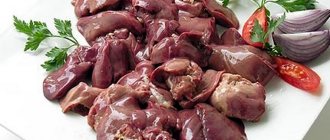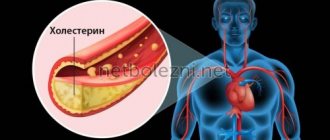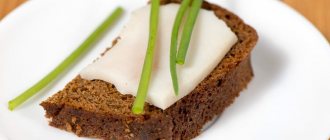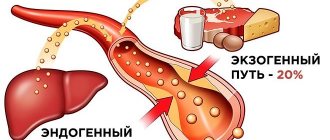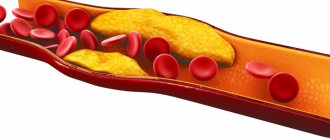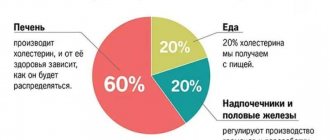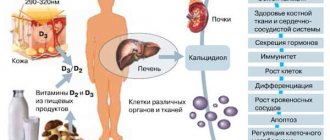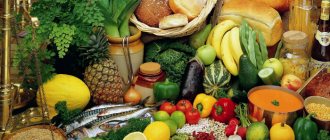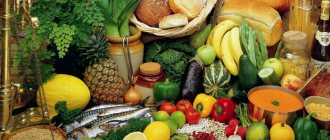You've had your blood cholesterol levels checked and your doctor has advised you to lower your cholesterol to avoid cardiovascular disease and other diseases caused by high cholesterol. For now - with the help of a cholesterol-lowering diet. The famous cardiologist Evgeniy Shlyakhto, General Director of the National Medical Research Center named after. V.A. Almazova.
To reduce cholesterol levels, the total amount of fat consumed should be reduced by about one third. The nature of fats in the diet also needs to change.
In Western Europe, the average fat intake for a sedentary adult is around 70–85 g per day. This corresponds to a daily calorie intake of 2100–2500 kcal. Chinese peasants, who enjoy enviable health, consume only 10% of their daily calorie intake from fat, and their blood cholesterol level is 3 mmol/l.
In order to reduce blood cholesterol levels by 10–20%, it is necessary to ensure that the daily energy balance in the body is minus 500 kcal from the required one. Saturated fats found in foods (mostly of animal origin) increase blood cholesterol levels, while unsaturated fats (of plant origin) help lower them. Monounsaturated fats, which are found in fish products, also help normalize blood cholesterol and blood triglycerides. When cooking, preference should be given to vegetable oils: olive, sunflower, soybean.
| Use as little as possible | Give preference |
| Butter, sour cream | Vegetables, fruits, salads |
| Hard cheeses and margarines | Poultry (chicken, turkey) without skin and visible fat |
| Pork of all varieties | Lean beef, veal, lamb, game |
| Fatty beef | All types of fish, especially fatty ones (they contain omega-3 fatty acids) |
| By-products (liver, kidneys, heart, brains) | Cereals, pasta |
| Sausages, sausages | Wholemeal bread, bran, muesli without sugar |
| Smoked meats, sausages, bacon, salami | Low-fat milk (1.5%), cottage cheese, milk yoghurt |
| Egg yolks | Vegetable oils (sunflower, peanut, soybean, corn, olive) |
| Fat cottage cheese | Beans, beans, soybeans |
| Fat poultry (ducks, geese) | Olives |
| Cakes, pastries, pastries | |
| Shrimp, crab, lobster, caviar | |
| Ice cream, desserts |
Now let's discuss individual food groups in a low-cholesterol diet.
General rules
The cholesterol factor (blood cholesterol level) determines the potential risk of developing a number of diseases: atherosclerosis , arterial hypertension , coronary artery disease, diabetes mellitus , myocardial infarction . It is important to understand that cholesterol is an important component of a number of biological reactions and is necessary for the construction of cell membranes, adrenal hormones, vitamin D3 , bile acids, and steroid hormones.
Normally, total cholesterol in the blood should not exceed 5 mmol/l. Most of the cholesterol (2/3) is synthesized in the human body, mainly in the liver, and 1/3 comes from food. The main form of cholesterol found in the blood plasma is represented by its esters (cholesterol + fatty acid), which form complexes with transporter proteins - lipoproteins . There are low-density lipoproteins (LDL) and high-density lipoproteins (HDL). About 70% of total cholesterol is associated with LDL, which are the main carriers of cholesterol from the liver to the periphery (to tissues), where their catabolism (metabolic breakdown) mainly occurs. Half-life is 3-4 days. Every day, about 70–80% of LDL is removed from the blood by receptor-mediated pathway. The remaining part is captured by phagocytic cells and it is this part that represents the main atherogenic (harmful) lipoprotein.
HDL is formed in the liver and in the intestines (from dietary lipids). HDL has the ability to absorb free cholesterol. High levels of HDL have been found to have a protective effect and prevent the development of cardiovascular diseases (beneficial lipoprotein). Dangerous in terms of the risk of developing atherosclerosis is considered not only an excess of total cholesterol, but also an excess of fractions and an imbalance between LDL/HDL, a general idea of the content of which in the blood is normal in the table below.
| Indicators of cholesterol and its fractions in the blood | Blood cholesterol concentration is normal |
| Total cholesterol | Less than 5.0 mmol/l. |
| Low-density lipoprotein cholesterol | 2.6-3.3 mmol/l. |
| High density lipoprotein cholesterol | For men - 1.0-1.3 mmol/l. For women - 1.2-1.5 mmol/l. |
In the origin of hypercholesterolemia, the leading role is given to the nature of nutrition, the presence of excess body weight, a sedentary lifestyle and bad habits (alcohol abuse/smoking).
Therefore, the main measures aimed at normalizing cholesterol levels are: an anti-cholesterol diet, normalizing body weight, and increasing physical activity. It has been reliably proven that in the general human population the average cholesterol level directly correlates with the nature of the diet and by correcting the diet, the cholesterol level in the blood can be reduced by 10-15%. In addition, increased LDL levels and decreased HDL levels are detected obese
The anti-cholesterol diet is aimed at normalizing lipid metabolism (mainly at reducing the concentration of total cholesterol and the LDL fraction and reducing body weight). The basis of therapeutic nutrition is reducing the consumption of animal/cooking fats (beef, lamb, pork, butter, mayonnaise, fatty meats, fish, cheese, egg yolk, offal) containing large amounts of cholesterol/saturated fats and replacing them with unrefined vegetable oils (flaxseed, sunflower, corn, olive, fish oil) containing a high level of polyunsaturated fats. It has been established that an increase in the content of ω-3 PUFAs in the diet normalizes lipid metabolism within 15-20 days (reduces the level of LDL and triglycerides, increases the content of HDL).
In the presence of metabolic syndrome , in particular obesity/disorders of carbohydrate metabolism, simple carbohydrates are also subject to mandatory restriction/exclusion from the diet. Correction of nutrition for increased body weight implies a reduction in the total calorie content of the daily diet, the level of which is determined by specific indicators of excess body weight in relation to the physiological norm. It is important to include in the diet foods containing fiber (grains, vegetables/fruits, bran), which effectively remove excess cholesterol from the gastrointestinal tract.
Fundamentally, the anti-cholesterol diet for women and the anti-cholesterol diet for men are no different. However, nutrition for women during menopause should be adjusted taking into account the fact that during this period estrogen , which has a negative effect on cholesterol metabolism. Therefore, the anti-cholesterol diet during this period should strictly correspond to the woman’s energy needs and prevent overeating, since eating fatty and high-calorie foods increases the concentration of LDL and decreases HDL.
An anti-cholesterol diet in women should contain, in maximum quantities, foods containing ω-3 PUFAs and phytosterols , which help reduce LDL levels. These products include sprouted wheat grains, flax seeds, sesame seeds, sunflower seeds, grape seed oil, fish oil, olive oil/olives, avocado, soy products.
Vegetables/fruits containing large amounts of pectin and polyphenols are also useful: eggplants, citrus fruits, apples, watermelons, beets, blueberries, raspberries, cranberries, plums, strawberries, chokeberries, purple/red grapes, pomegranate, natural vegetable/fruit juices, which stimulate the production of HDL.
It is also necessary to include legumes, green leafy salads, and garden herbs in your diet. It is important to limit the consumption of products containing simple carbohydrates (sugar, chocolate, cream products, honey, sweets, jam, baked goods, waffles), replacing them with products containing complex carbohydrates (whole grain cereals, grain bread, legumes, vegetables, unsweetened fruits).
| Foods high in OX (mg) | Products with average TC content (mg) | Products with low TC content (mg) |
| Brains (900-2000) | Rabbit meat (90) | Pork tongue (48) |
| Pork kidneys (250-800) | Medium fat fish (85) | Horse mackerel (40) |
| Quail eggs (550) | Chicken/dark meat without skin (80) | Low-fat boiled sausage (40) |
| Beef liver (350-400) | Cream 20% (82) | Cod (30) |
| Chicken liver (490) | Chicken/white meat without skin (75) | Sour cream 10% (32) |
| Pork (360-380) | Lamb (70) | Goat milk (30) |
| Sevruga, mackerel (360) | Lean beef (65) | Milk 3% (12) |
| Butter (240-280) | Processed cheese (64) | Kefir 1% (3.0) |
| Carp (270) | Shellfish (55) | Serum (2.2) |
| Oysters (175) | Chicken (50-60) | Low-fat cottage cheese (1.1) |
| Sardines – canned in oil (140) | Cheese "Kostromskoy" (55) | Homemade cheese (0.5) |
| Pork liver (135) | Trout, tuna (56) | Low-fat yogurt (0.8) |
| Cream cheese 60% (110) | Duck (65) | Margarine (0) |
| Pork/goose fat (100) | Turkey (40-650) | Vegetable oils (0) |
| Veal/lamb (95) | Pork tongue (52) | — |
| Herring (98) | Pike (50) | — |
When cooking food, it is necessary to use a minimum of fat, giving preference to baking and steaming. The table above gives a general idea of the cholesterol content in food.
Along with diet, the most important factor in treatment is increased physical activity, which increases metabolism and accelerates the process of mobilizing fat from the depot, as well as giving up bad habits (smoking, alcohol).
What does “bad” cholesterol mean?
A “good” lipoprotein has a high density, and a “bad” one has a low density. Lipoprotein is cholesterol in an apolipoprotein shell.
What does high density mean? The fact is that the cholesterol itself in the compound is only a small part and the main composition is protein. This ratio is most optimal for the body, since the lipid easily enters the liver and exits along with bile, without settling along the way. Therefore he is "good".
Low-density lipoprotein, on the contrary, contains a lot of cholesterol and is excreted poorly, clogging blood vessels and causing atherosclerosis.
With age, cholesterol accumulates in the body: in a child it is much less than in an adult. This accumulation process does not stop throughout life: the older a person is, the higher his cholesterol level.
| Age | Cholesterol level |
| 25+ | Men: 6.33 Women: 5.74 |
| 35+ | Men: 6.57 Women: 5.94 |
| 45+ | Men: 6.93 Women: 6.54 |
| 55+ | Men: 7.39 Women: 7.14 |
| 65+ | Men: 7, 68 Women: 7, 50 |
| 70+ | Men: 7, 88 Women: 7, 72 |
If cholesterol levels are higher than the given norm, you should consult a doctor. It is also extremely important to maintain proper nutrition. It is advisable to worry about an anti-cholesterol diet at a young age, but in adulthood this must be done.
The fact is that lipoprotein excess leads to the formation of cholesterol plaques on the walls of the arteries. These plaques, overgrown with calcium ions, completely close the lumen in the vessels. As a result, blood flow slows down.
High cholesterol increases the risk of the following conditions:
- oncology;
- stroke;
- cardiac ischemia;
- peripheral vascular pathologies;
- heart attack;
- hypertension;
- diabetes.
Authorized Products
The basis of the anti-cholesterol diet is:
- Dishes from sea/river fish (pike, tuna, mackerel, flounder, cod, hake, salmon, salmon, trout) and seafood (except squid) at least 100 g 2-3 times a week. It is useful to include seaweed in the form of salads in your diet.
- Lean red meat and poultry (turkey, chicken), boiled/baked rabbit meat.
- Vegetable soups with a small amount of cereal without frying, borscht, cabbage soup, beetroot soup.
- Rye/grain bread, with bran, flax or sesame seeds, dry biscuits, whole grain bread
- Porridges made from buckwheat and oatmeal, well boiled, brown rice, pasta made from wholemeal flour/durum wheat.
- Fresh fruits/vegetables (at least 400 g/day), both in the form of side dishes and in the form of salads, seasoned with vegetable oil. Be sure to include in your diet (if tolerated) legumes, which contain a lot of vegetable protein. It is also recommended to consume fruits/berries (except bananas/grapes) raw or in the form of compotes, jellies and decoctions. They stimulate metabolic processes and normalize intestinal function.
- In addition to vegetables/fruits, it is recommended to take sesame and flax seeds, fenugreek, and bran ground in a coffee grinder. It is better to consume bran in the morning and at night before meals, 2 teaspoons, with plenty of water.
- Freshly prepared juices (apple, orange, grapefruit, berry juices). From vegetable juices - beet/carrot juices. It is recommended to include oatmeal jelly/decoction in your diet, which effectively removes cholesterol .
- Nuts, especially walnuts (at least 30 g/day), sunflower seeds, pumpkin.
- Milk/fermented milk products/low-fat cottage cheese, cheeses with a fat content of no more than 20-30%, and use sour cream and low-fat cream exclusively in ready-made dishes. It is allowed to include 1-2 whole chicken eggs per week in the diet and unlimited egg whites.
- Unrefined, cold-pressed vegetable oils (olive, sesame, corn, and flaxseed), mainly for seasoning ready-made dishes. Especially useful.
- Green/herbal tea with lemon, still mineral water, rosehip decoction up to 2.0 l/day.
Table of permitted products
| Proteins, g | Fats, g | Carbohydrates, g | Calories, kcal | |
Vegetables and greens | ||||
| eggplant | 1,2 | 0,1 | 4,5 | 24 |
| beans | 6,0 | 0,1 | 8,5 | 57 |
| zucchini | 0,6 | 0,3 | 4,6 | 24 |
| cabbage | 1,8 | 0,1 | 4,7 | 27 |
| broccoli | 3,0 | 0,4 | 5,2 | 28 |
| Brussels sprouts | 4,8 | 0,0 | 8,0 | 43 |
| cauliflower | 2,5 | 0,3 | 5,4 | 30 |
| green onion | 1,3 | 0,0 | 4,6 | 19 |
| bulb onions | 1,4 | 0,0 | 10,4 | 41 |
| carrot | 1,3 | 0,1 | 6,9 | 32 |
| cucumbers | 0,8 | 0,1 | 2,8 | 15 |
| squash | 0,6 | 0,1 | 4,3 | 19 |
| salad pepper | 1,3 | 0,0 | 5,3 | 27 |
| parsley | 3,7 | 0,4 | 7,6 | 47 |
| salad | 1,2 | 0,3 | 1,3 | 12 |
| beet | 1,5 | 0,1 | 8,8 | 40 |
| celery | 0,9 | 0,1 | 2,1 | 12 |
| soybeans | 34,9 | 17,3 | 17,3 | 381 |
| asparagus | 1,9 | 0,1 | 3,1 | 20 |
| tomatoes | 0,6 | 0,2 | 4,2 | 20 |
| Jerusalem artichoke | 2,1 | 0,1 | 12,8 | 61 |
| pumpkin | 1,3 | 0,3 | 7,7 | 28 |
| dill | 2,5 | 0,5 | 6,3 | 38 |
| beans | 7,8 | 0,5 | 21,5 | 123 |
| garlic | 6,5 | 0,5 | 29,9 | 143 |
| lentils | 24,0 | 1,5 | 42,7 | 284 |
Fruits | ||||
| avocado | 2,0 | 20,0 | 7,4 | 208 |
| oranges | 0,9 | 0,2 | 8,1 | 36 |
| pomegranate | 0,9 | 0,0 | 13,9 | 52 |
| grapefruit | 0,7 | 0,2 | 6,5 | 29 |
| pears | 0,4 | 0,3 | 10,9 | 42 |
| lemons | 0,9 | 0,1 | 3,0 | 16 |
| mango | 0,5 | 0,3 | 11,5 | 67 |
| tangerines | 0,8 | 0,2 | 7,5 | 33 |
| nectarine | 0,9 | 0,2 | 11,8 | 48 |
| peaches | 0,9 | 0,1 | 11,3 | 46 |
| apples | 0,4 | 0,4 | 9,8 | 47 |
Berries | ||||
| gooseberry | 0,7 | 0,2 | 12,0 | 43 |
| Red currants | 0,6 | 0,2 | 7,7 | 43 |
| black currant | 1,0 | 0,4 | 7,3 | 44 |
Nuts and dried fruits | ||||
| nuts | 15,0 | 40,0 | 20,0 | 500 |
| almond | 18,6 | 57,7 | 16,2 | 645 |
| flax seeds | 18,3 | 42,2 | 28,9 | 534 |
| fenugreek seeds | 23,0 | 6,4 | 58,3 | 323 |
| sunflower seeds | 20,7 | 52,9 | 3,4 | 578 |
Cereals and porridges | ||||
| buckwheat (kernel) | 12,6 | 3,3 | 62,1 | 313 |
| oat groats | 12,3 | 6,1 | 59,5 | 342 |
| cereals | 11,9 | 7,2 | 69,3 | 366 |
| wheat bran | 15,1 | 3,8 | 53,6 | 296 |
Raw materials and seasonings | ||||
| basil | 2,5 | 0,6 | 4,3 | 27 |
| honey | 0,8 | 0,0 | 81,5 | 329 |
Dairy | ||||
| kefir 0% | 3,0 | 0,1 | 3,8 | 30 |
| kefir 1% | 2,8 | 1,0 | 4,0 | 40 |
Cheeses and cottage cheese | ||||
| cottage cheese 0.6% (low fat) | 18,0 | 0,6 | 1,8 | 88 |
| curd tofu | 8,1 | 4,2 | 0,6 | 73 |
Meat products | ||||
| beef | 18,9 | 19,4 | 0,0 | 187 |
Bird | ||||
| chicken fillet | 23,1 | 1,2 | 0,0 | 110 |
| turkey | 19,2 | 0,7 | 0,0 | 84 |
Eggs | ||||
| eggs | 12,7 | 10,9 | 0,7 | 157 |
Fish and seafood | ||||
| fish | 18,5 | 4,9 | 0,0 | 136 |
| seaweed | 0,8 | 5,1 | 0,0 | 49 |
Oils and fats | ||||
| grape seed oil | 0,0 | 99,9 | 0,0 | 899 |
| linseed oil | 0,0 | 99,8 | 0,0 | 898 |
| olive oil | 0,0 | 99,8 | 0,0 | 898 |
| sunflower oil | 0,0 | 99,9 | 0,0 | 899 |
Non-alcoholic drinks | ||||
| mineral water | 0,0 | 0,0 | 0,0 | — |
| instant chicory | 0,1 | 0,0 | 2,8 | 11 |
| green tea | 0,0 | 0,0 | 0,0 | — |
| * data is per 100 g of product | ||||
Oils and nuts: which ones to choose?
Butter and margarine contain the same amount of fat (up to 81 g per 100 g), but these fats differ in their composition. Butter contains a lot of saturated fatty acids (about 63%) and about 4% of so-called trans fatty acids (partially hydrogenated vegetable fats). Trans fatty acids are recognized as harmful to health.
Compared to butter, all types of margarines contain lower amounts of saturated fatty acids, and margarines labeled “high in polyunsaturated acids” contain a large amount of trans fatty acids, which, along with saturated fats, cannot be recommended in the diet of patients with hypercholesterolemia.
Olive oil is an ideal product from the point of view of the concept of the so-called Mediterranean diet and low cholesterol nutrition. Olive oil is absorbed by the body by 98%, while sunflower oil is only 65%.
Olive oil has been used by humans for thousands of years and is considered one of the oldest foods. Like wine, olive oil comes in different flavors, colors and aroma as it is grown in different climates and soils and harvested in different ways.
Olive oil is divided into several grades based on flavor and acidity. Extra Virgin Olive Oil is produced from selected quality olives. It has excellent taste and aroma and does not require cleaning. The acidity of this oil is no more than 1%.
“Virgin Olive Oil” is also an excellent product that does not require purification. It has a high standard of taste and aroma, and its acidity is no more than 2%.
“Olive oil” is an oil that initially has a high percentage of acidity. It is processed (refined) and flavored with “super natural” olive oil. Its acidity is no more than 1.5%.
Olive oil can serve as a salad dressing, a marinade for meat and fish, it is resistant to high temperatures and is widely used for frying and baking.
Nuts are a very healthy and nutritious product. Nuts contain a large amount of calories, vegetable protein and unsaturated fatty acids. Recent evidence suggests that eating certain types of nuts (such as walnuts) leads to a modest reduction in cholesterol by up to 12%.
Brazil nuts are an excellent source of selenium. Selenium is an important trace element that is involved in oxidative processes, normal thyroid function and the production of the sex hormone testosterone, and also ensures normal sperm motility. Three whole Brazil nuts (10 g) provide the daily dose of selenium - 153 mcg (daily value for men - 75 mcg, for women - 60 mcg).
Fully or partially limited products
When following an anti-cholesterol diet, the following are excluded from the diet:
- Fatty red meats, offal, waterfowl meat (duck, goose), sausages, smoked meats, animal/cooking fats.
- Meat/fish broths, canned fish, fried foods, fish roe, crayfish, crabs, shrimp, cod liver.
- Cream pies, cakes, pastries, puff pastry products.
- Semolina, white rice, pasta.
- Full-fat cottage cheese, cheese, sour cream and cream, chicken egg yolks, products with palm/coconut oil.
- Chocolate, cocoa, ice cream, strong black tea/coffee.
- Products containing easily digestible carbohydrates - honey, jam, jam, sugar, confiture.
Table of prohibited products
| Proteins, g | Fats, g | Carbohydrates, g | Calories, kcal | |
Fruits | ||||
| bananas | 1,5 | 0,2 | 21,8 | 95 |
Nuts and dried fruits | ||||
| raisin | 2,9 | 0,6 | 66,0 | 264 |
Cereals and porridges | ||||
| semolina | 10,3 | 1,0 | 73,3 | 328 |
| white rice | 6,7 | 0,7 | 78,9 | 344 |
Flour and pasta | ||||
| pasta | 10,4 | 1,1 | 69,7 | 337 |
Bakery products | ||||
| bagels | 16,0 | 1,0 | 70,0 | 336 |
| bagels | 16,0 | 1,0 | 70,0 | 336 |
| crackers | 11,2 | 1,4 | 72,2 | 331 |
Confectionery | ||||
| jam | 0,3 | 0,2 | 63,0 | 263 |
| jam | 0,3 | 0,1 | 56,0 | 238 |
| candies | 4,3 | 19,8 | 67,5 | 453 |
| pastry cream | 0,2 | 26,0 | 16,5 | 300 |
Ice cream | ||||
| ice cream | 3,7 | 6,9 | 22,1 | 189 |
Cakes | ||||
| cake | 4,4 | 23,4 | 45,2 | 407 |
Chocolate | ||||
| chocolate | 5,4 | 35,3 | 56,5 | 544 |
Raw materials and seasonings | ||||
| ketchup | 1,8 | 1,0 | 22,2 | 93 |
| mayonnaise | 2,4 | 67,0 | 3,9 | 627 |
Dairy | ||||
| cream | 2,8 | 20,0 | 3,7 | 205 |
| sour cream 30% | 2,4 | 30,0 | 3,1 | 294 |
| sour cream 40% (fat) | 2,4 | 40,0 | 2,6 | 381 |
Cheeses and cottage cheese | ||||
| cheese | 24,1 | 29,5 | 0,3 | 363 |
| cottage cheese 18% (fat) | 14,0 | 18,0 | 2,8 | 232 |
Meat products | ||||
| pork | 16,0 | 21,6 | 0,0 | 259 |
| pork liver | 18,8 | 3,6 | 0,0 | 108 |
| pork kidneys | 13,0 | 3,1 | 0,0 | 80 |
| pork fat | 1,4 | 92,8 | 0,0 | 841 |
| salo | 2,4 | 89,0 | 0,0 | 797 |
| beef liver | 17,4 | 3,1 | 0,0 | 98 |
| beef kidneys | 12,5 | 1,8 | 0,0 | 66 |
| beef brains | 9,5 | 9,5 | 0,0 | 124 |
| mutton | 15,6 | 16,3 | 0,0 | 209 |
Sausages | ||||
| smoked sausage | 16,2 | 44,6 | 0,0 | 466 |
| smoked sausage | 9,9 | 63,2 | 0,3 | 608 |
| sausages | 10,1 | 31,6 | 1,9 | 332 |
| sausages | 12,3 | 25,3 | 0,0 | 277 |
Bird | ||||
| smoked chicken | 27,5 | 8,2 | 0,0 | 184 |
| duck | 16,5 | 61,2 | 0,0 | 346 |
| smoked duck | 19,0 | 28,4 | 0,0 | 337 |
| goose | 16,1 | 33,3 | 0,0 | 364 |
Fish and seafood | ||||
| smoked fish | 26,8 | 9,9 | 0,0 | 196 |
| salted fish | 19,2 | 2,0 | 0,0 | 190 |
| Red caviar | 32,0 | 15,0 | 0,0 | 263 |
| black caviar | 28,0 | 9,7 | 0,0 | 203 |
| squid | 21,2 | 2,8 | 2,0 | 122 |
| shrimps | 22,0 | 1,0 | 0,0 | 97 |
| salmon | 19,8 | 6,3 | 0,0 | 142 |
| sturgeon | 16,4 | 10,9 | 0,0 | 163 |
| canned fish | 17,5 | 2,0 | 0,0 | 88 |
| semi-finished fish products | 12,5 | 6,7 | 14,7 | 209 |
| sardine | 20,6 | 9,6 | — | 169 |
| mackerel | 18,0 | 13,2 | 0,0 | 191 |
| cod (liver in oil) | 4,2 | 65,7 | 1,2 | 613 |
| boiled oysters | 14,0 | 3,0 | — | 95 |
| fresh oysters | 14,0 | 6,0 | 0,3 | 95 |
Oils and fats | ||||
| butter | 0,5 | 82,5 | 0,8 | 748 |
| creamy margarine | 0,5 | 82,0 | 0,0 | 745 |
| coconut oil | 0,0 | 99,9 | 0,0 | 899 |
| palm oil | 0,0 | 99,9 | 0,0 | 899 |
| rendered beef fat | 0,0 | 99,7 | 0,0 | 897 |
| cooking fat | 0,0 | 99,7 | 0,0 | 897 |
| rendered pork fat | 0,0 | 99,6 | 0,0 | 896 |
Non-alcoholic drinks | ||||
| cola | 0,0 | 0,0 | 10,4 | 42 |
| lemonade | 0,0 | 0,0 | 6,4 | 26 |
| Pepsi | 0,0 | 0,0 | 8,7 | 38 |
| sprite | 0,1 | 0,0 | 7,0 | 29 |
| * data is per 100 g of product | ||||
Quitting the diet
To maintain positive dynamics after completing the low-cholesterol course, you should lead a healthy lifestyle, give up smoking, excessive alcohol consumption, and junk food. Make sport a part of your life. Swimming, Pilates, yoga, walking and any aerobic exercise will have a beneficial effect on the condition of the heart and blood vessels. However, pay special attention to nutrition. Subsequently, the diet should consist of foods that regulate blood cholesterol levels, namely:
Fish containing large amounts of Omega-3 PUFAs
Herring, salmon, salmon, trout, and tuna prevent the formation of atherosclerotic plaques, strengthen blood vessels and contain many B vitamins.
Cabbage
White cabbage, cauliflower, kohlrabi, and broccoli prevent the absorption of cholesterol.
Buckwheat
Due to the high content of lecithin, porridge breaks down cholesterol and removes it from the body, reducing the risk of plaques and blood clots. It is advisable to buy “green” buckwheat that has not been roasted.
Apples
Apple pectin and tannin regulate lipid and sugar levels, so eating raw and baked apples is a great way to strengthen the walls of blood vessels, improve metabolism and lose several kilograms. Fresh raspberries have the same effect.
Berries and fruits of blue, purple, and red colors
Due to the polyphenol content in them, the synthesis of “good” cholesterol increases by 3%.
Garlic
It is recommended to eat one or two cloves of garlic per day. You can replace it with pharmaceutical supplements in capsule form.
Oyster mushrooms
Just 10 grams of oyster mushrooms per day slows down the absorption of harmful substances. This is due to the content of a special natural component in mushrooms - lovastine.
Barley
Beta-glucans contained in cereals slow down the absorption of harmful fat by the intestines, thereby reducing cholesterol levels in the body.
Legumes
Beans, chickpeas, peas, lentils, and other legumes are rich not only in fiber, but also in healthy vegetable protein.
Lean meat
It is not advisable to limit meat consumption, because it contains iron that is beneficial for the body. However, it is necessary to choose low-fat varieties, cut off the skin from the bird, and also drain the “first” broth when preparing first courses.
Avocado
The high content of monounsaturated fats makes avocados an indispensable product of proper nutrition.
Spinach, lettuce
Nuts
Nutritionists say that regular consumption of walnuts, almonds and cashews effectively reduces the level of harmful substances and the risk of heart and vascular diseases.
It is also advisable to take multivitamins, especially calcium and magnesium supplements.
Anti-cholesterol diet menu (Diet)
The anti-cholesterol diet menu involves 5-6 meals a day. You are allowed to eat an apple, carrot, grapefruit or fermented milk product during the day when you feel hungry. A sample menu for the week is given below.
Monday
| Breakfast |
|
| Lunch |
|
| Dinner |
|
| Afternoon snack |
|
| Dinner |
|
Tuesday
| Breakfast |
|
| Lunch |
|
| Dinner |
|
| Afternoon snack |
|
| Dinner |
|
Wednesday
| Breakfast |
|
| Lunch |
|
| Dinner |
|
| Afternoon snack |
|
| Dinner |
|
Thursday
| Breakfast |
|
| Lunch |
|
| Dinner |
|
| Afternoon snack |
|
| Dinner |
|
Friday
| Breakfast |
|
| Lunch |
|
| Dinner |
|
| Afternoon snack |
|
| Dinner |
|
Saturday
| Breakfast |
|
| Lunch |
|
| Dinner |
|
| Afternoon snack |
|
| Dinner |
|
Below are several recipes for cooking to lower cholesterol .
Principles of nutrition
- Fish is a must-have product for those who want to reduce cholesterol levels. Of the fish, salmon, pink salmon, and hake, that is, low-fat varieties, are especially valuable.
- Despite the fact that this diet involves eliminating cholesterol as much as possible, some foods should contain some amount of cholesterol. This is explained by the fact that the body needs lipoproteins for normal functioning.
- Meals should be divided, in small portions, at least 5 times a day. One serving – no more than 200 grams.
- The last meal should be no later than three hours before bedtime.
- You need to drink at least 2 liters of clean, unboiled water.
- Salt from the diet must be reduced, if not removed. It is better to salt already prepared food and reduce it to a teaspoon per day. Salt inhibits kidney function, retains moisture and interferes with the removal of cholesterol.
- All recipes must be steamed or boiled. Fried and fatty foods are completely excluded.
- If you are hungry, you can drink a glass of clean water, or, in extreme cases, low-fat kefir. It is generally better not to drink anything at night, as water and other liquids provoke swelling.
- Sometimes it is better to replace breakfasts with a healthy salad of grated carrots with lemon juice. This breakfast cleanses the gastrointestinal tract well, cleanses the blood and blood vessels.
- To lower cholesterol, be sure to consume garlic, onions and olive oil.
Recipes
Pike perch baked with vegetables
Cut pike perch fillet (0.5 kg) into portions, brush with oil, season with fish spices and dry herbs. Place prepared and seasoned vegetables (zucchini, eggplant, garlic, onions, sweet peppers) on top of the fish fillet and cover with tomatoes, Provençal herbs, and bake for 20-30 minutes.
Hake baked with cheese and vegetables
Carrot fillet, onions, tomatoes, low-fat cheese 50 g, vegetable oil.
Cut hake fillet (500 g) into portions, marinate in allspice and fish spices. Separately, simmer grated carrots and finely chopped onions in vegetable oil. Place the marinated hake fillet in a baking dish and cover with a layer of stewed vegetables. Bake for 30 minutes, after 20 minutes sprinkle with grated cheese and place in the oven for 10 minutes.
Chicken breast baked in the oven
Chicken fillet (300 g) beat and marinate for 30-40 minutes in olive oil with the addition of milk, garlic, rosemary. Bake in the oven in a mold/foil. Lightly salt the finished dish and serve with fresh vegetables.
Juice therapy
In addition to special nutrition, nutritionists have also developed a method for reducing the overall level of fats in the blood by drinking juices according to a special scheme.
The duration of the course is 5 days. During this time, in the morning, on an empty stomach, you need to drink fresh juice (freshly squeezed juice).
First day: 70 ml celery juice and 130 ml carrot juice.
Second day: mix 70 ml of beet juice with 100 ml of carrot juice and 70 ml of cucumber juice.
Beetroot juice must be squeezed out 1.5-2 hours before consumption.
Third day: mix 70 ml apple juice and 70 ml celery juice with 130 ml fresh carrot juice.
Fourth day: add 70 ml of apple juice to 130 ml of carrot juice.
Fifth day: 130 ml orange juice.
Juice therapy can reduce TC by 10% and lose a little weight.
Advantages and disadvantages
| pros | Minuses |
|
|
Advantages and disadvantages of the anti-cholesterol menu
Such nutrition helps improve health, stabilize metabolism, accelerate metabolism, start losing weight and normalize weight. Due to a rich diet, you will not have to constantly feel hungry and the danger of a “breakdown” is reduced to zero. The menu can be tailored to suit your financial capabilities and individual preferences. Taking additional vitamins and minerals reduces the risk of vitamin deficiency to zero, and having a large amount of fruits and vegetables in the diet helps strengthen the immune system.
There are no disadvantages to this diet. However, it should be remembered that it should be carried out with the consent of a doctor and under his supervision, since a sharp decrease in cholesterol levels will bring more time to the body than benefit.
Reviews and results
The anti-cholesterol diet, according to patients, is a fairly effective remedy, and in combination with increased physical activity, smoking cessation and medications, it can normalize blood cholesterol levels.
- “... I have been struggling with high cholesterol for almost 2 years. For the last 2 months I’ve been on a strict diet, because my cholesterol levels, although they are decreasing, are not as fast as I would like. I excluded almost all animal fats, potatoes, rice, pasta, sugar, most sweets and everything fried. I limited chicken eggs, now I eat only whites, removed cream and cheese. I hope this will help, but if not, I’ll have to take medications”;
- “... I decided to adjust my cholesterol levels because I am afraid of coronary artery disease (my parents and relatives have cardiovascular diseases). I started with losing weight, since my weight exceeds the norm by almost 13 kg. After 4 months, I lost 10 kg and switched to an anti-cholesterol diet. I strictly limit myself; I also quit smoking and started going to the gym with my son to play volleyball. Now the numbers are approaching normal, but the doctor warned me that I still need to monitor my weight and continue to eat right, although maybe not with such strict restrictions.”
What is cholesterol
Cholesterol is a type of lipid present in the cells of animals and humans. The body synthesizes the bulk, and about 20% comes from food. Cholesterol is necessary for a person if it does not exceed the permissible norm, because it:
- strengthens cell membranes;
- participates in digestion;
- normalizes hormonal levels;
- provides protection to nerve fibers;
- reduces cellular permeability;
- Helps the body produce vitamin D.
In other words, a person needs cholesterol so that he can survive. But it is important to distinguish between “good” cholesterol and “bad” cholesterol.
Fish and omega-3 fatty acids
Fish and omega 3 fatty acids
Eating fatty fish is good for your heart because it contains high amounts of omega-3 fatty acids, which reduce blood pressure and the risk of blood clots. In people who have had heart attacks, fish oil and omega-3 fatty acids reduce the risk of sudden death.
Cardiologists recommend eating at least 2 servings of fish per week. The largest amounts of omega-3 fatty acids contain:
- mackerel;
- river trout;
- herring;
- sardines;
- longfin tuna;
- salmon;
- halibut.
To avoid adding unhealthy fats, fish should be baked or grilled. If you don't like fish, you can get some omega-3 fatty acids from foods like flaxseed meal, camelina oil, or canola oil.
Another option is to take omega-3 fatty acid or fish oil supplements, but then you won't get other nutrients that fish also contain (such as selenium). If you plan to use such supplements, please consult your physician first.
Folk remedies in the fight against cholesterol
You can combat high levels of unhealthy fats not only with diets and healthy foods, but also with the use of folk remedies. Be sure to remember that the use of any prescriptions should occur after consultation with your doctor. Allergic reactions may occur due to individual intolerance to the components. We offer several proven ways to reduce cholesterol:
Dill seed tincture
Ingredients:
- half a glass of dill seeds;
- a tablespoon of crushed valerian root;
- a glass of honey.
Cooking method:
- Mix the ingredients, pour 1 liter of boiling water, leave for 24 hours. Keep refrigerated.
Mode of application:
- A tablespoon three times a day 30-40 minutes before meals.
Garlic oil
Ingredients:
- 2 cups olive oil;
- 10 cloves of garlic.
Cooking method:
- Add garlic, previously passed through a press, to the oil. Leave for 7 days.
Mode of application:
- Use as a flavorful seasoning for salads and other favorite dishes.
Garlic tincture
Ingredients:
- garlic – 400 g;
- vodka – 250 g.
Cooking method:
- Pass the garlic through a press or chop it in a garlic press. Pour vodka (or alcohol) and keep in a dark place for 10 days.
Mode of application:
Take on an empty stomach (it is better to add it to milk), half an hour before meals according to the following scheme:
First week
You need to start with two drops and increase the amount of tincture every day so that on the seventh day you take 17-20 drops.
Second week
20 drops three times a day 30 minutes before meals.
Third week
Gradually reduce the amount of tincture you use from 20 drops so that you end the seventh day with 2 drops.
This treatment regimen can be repeated once every three years.
Dry linden blossom (linden flour)
Cooking method:
- Grind linden flowers in a coffee grinder until it becomes flour.
Mode of application:
- Three times a day, a teaspoon. Drink with a glass of water.
Duration of treatment is 1 month. After a 14-day break, the course is repeated.
Healthy dessert
Ingredients (all in equal proportions):
- lemons;
- honey;
- dried apricots;
- raisin;
- walnuts.
Cooking method:
- Pass dried fruits through a meat grinder, pour in natural honey, leave for a day.
Mode of application:
- Eat a tablespoon of the sweet mixture half an hour before breakfast.
The healthy dessert must be stored in the refrigerator.
4% propolis tincture
Directions for use: dissolve 7 drops in 40 ml of water, take 3 times a day 40 minutes before meals. Course duration: 4 months.
Celery
An excellent option for breakfast or afternoon snack during a cholesterol diet.
Cooking method:
- Place celery stalks in boiling water for 2-3 minutes. Cool, sprinkle with vegetable oil, sprinkle with sesame seeds and add a little honey.
Horseradish with sour cream
Ingredients:
- horseradish root;
- a glass of low-fat sour cream.
Cooking method:
- Grind the horseradish root, add sour cream.
Mode of application:
- 3-4 times a day along with meals.
Flax-seed
Flax and flaxseed have proven themselves to be an excellent anti-sclerotic agent. You can take flaxseed oil, decoctions and tinctures, and also eat flaxseed.
Herbal decoctions
Decoctions of various herbs are also part of lipid-lowering therapy. Dandelion roots, alfalfa, licorice, corn silk, buckthorn, motherwort, mint, golden mustache, hawthorn and many others are suitable for this purpose.
What foods are prohibited to eat?
Experts advise completely excluding from the menu:
What foods are high in cholesterol?
- pork;
- beef;
- game;
- offal;
- canned food;
- margarine, spreads and butter;
- fatty dairy products;
- alcoholic drinks;
- sweet soda;
- sweet baked goods and confectionery products.
The listed products contain large amounts of cholesterol, animal fat and trans fats. In addition, it is unacceptable to snack on fast food, semi-finished products containing large amounts of salt, flavorings, trans isomers of fatty acids that have low nutritional value.
If you continue to eat such foods, you can provoke the occurrence of:
- vitamin deficiency;
- dyslipidemia;
- cardiovascular diseases.
No ads 1
The need to follow a diet
By following the diet recommended by a specialist, you can regulate the content of high and low density lipoproteins. Thanks to this, the level of bad cholesterol is significantly reduced. Proper nutrition when cholesterol increases can normalize its content in the body without drug treatment.
This cleanses the blood vessels, normalizes blood circulation, and has a beneficial effect on the cardiovascular system. The recommended products contain a large percentage of antioxidants, which helps slow down the aging of the skin, prevent the development of pathologies of internal organs and increase vitality.
Recipes for high cholesterol
Summer salad
To prepare you will need:
- 300 g cabbage (red or white).
- A handful of chopped nettle leaves.
- One onion.
- 3 tbsp. l. olive oil.
- A little salt (or better yet, avoid using it).
Finely chop the cabbage and onion, chop the nettle leaves with a knife. Mix the ingredients and season the salad with oil.
Potato soup with buckwheat
Ingredients:
- Water – 3 l.
- Potatoes - 7 medium-sized pieces.
- Buckwheat – 100 g.
- Half a parsley root.
- Carrots – 1 pc.
- Onion – 1 pc.
- Sunflower oil – 3 tbsp. l.
- Greens, salt, pepper - to taste.
Before preparing the soup, it is recommended to heat the buckwheat in a frying pan, which will have a positive effect on its taste. Afterwards, buckwheat should be boiled in a small amount of water.
Boil 2-2.5 liters of water in a saucepan and put pre-peeled and diced potatoes into it. After 10 minutes from the moment of boiling, put boiled buckwheat, grated carrots, finely chopped onion and parsley root into the pan. After 10 minutes, add salt to the soup, add chopped herbs and leave on low heat (5 minutes).
Millet-pumpkin porridge
Prepared from 700 g pumpkin pulp and 300 g millet. First you need to cut the pumpkin into cubes and boil it in 1 liter of water. After 15 minutes, add the required amount of washed millet to the pan. Cook the porridge over moderate heat for at least 30 minutes. The finished dish can be slightly salted and seasoned with pumpkin seed oil.
Is it possible to reduce cholesterol with a diet for diabetes? The nutritional rules, in this case, are identical. Therefore, diets are interchangeable.
Low cholesterol: dangers and complications
When working to lower your bad cholesterol levels, you should remember that common sense and the right approach to diet are the key to success. When removing “bad” fats, you can overdo it and deprive the body of such useful and necessary “good” nutrients.
You should be concerned if during treatment you notice the appearance or worsening of the following conditions:
- decreased or lack of appetite;
- intestinal disorder;
- muscular dystonia;
- drowsiness, lethargy, slow reaction;
- sudden mood swings, aggression, depressive syndromes;
- decline in sexual activity.
All this may indicate low total cholesterol.
Why is it dangerous?
- Vessels become vulnerable and fragile, cerebral circulation worsens.
- A decrease in serotonin synthesis due to the lack of healthy fats leads to depression, suicidal conditions, increased anxiety, and sleep disorders. In older people it provokes dementia (senile insanity), Alzheimer's disease.
- The level of production and absorption of fat-soluble vitamins, including vitamin D and calcium, sharply decreases. The result is osteoporosis.
- People with low TC are at risk for infertility, because sex hormones require cholesterol.
- Insulin resistance is impaired, which leads to type 2 diabetes.
Therefore, if you feel worse, you should see a doctor and take another blood test. The doctor will be able to take timely measures and adjust your diet.
The effect of diet on the intestines
Proper nutrition helps maintain normal internal balance of the intestines. Diet number 3 for constipation is aimed at improving and stimulating the basic functions of the intestinal microflora, such as:
- synthesis of amino acids and vitamins K and C, as well as B vitamins;
- local immune defense of the body;
- enzymatic processing of dietary fiber;
- neutralization of toxins;
- maintaining the secretory activity of the gastrointestinal tract.
Diet number three restores the functional activity of the intestines, normalizes metabolic processes, improves motility and secretion of intestinal glands. The diet prevents fermentation and the formation of gases, promotes the elimination of toxic compounds, and also normalizes fluid exchange. The healing table ensures normal digestion and timely bowel movements.
